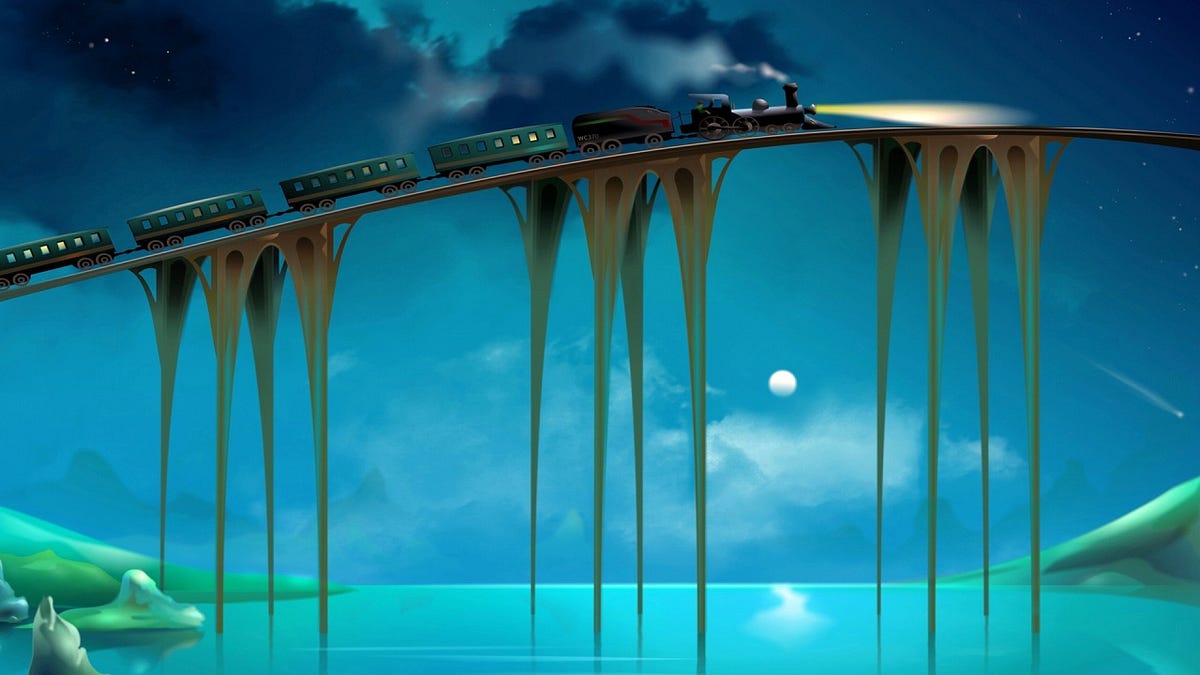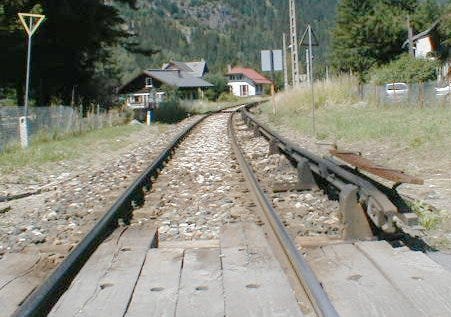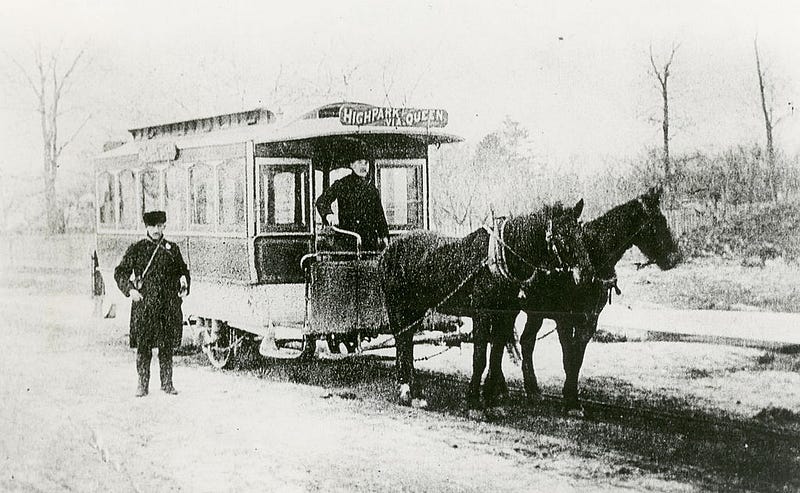
“The sins of the father are to be laid upon the children” — William Shakespeare
In rail transport, the track gauge is the spacing of the rails on a railway track and is measured between the inner faces of the load-bearing rails.
The standard gauge in the U.S. is four-feet, eight-and-a-half inches. Very exact isn’t it? For the curious here is why…

- The US railroad system was built by ex-patriot English workers. The UK pioneered rail travel. This was the standard gauge they had used in the UK.
- The English based the gauges on that width because that was the gauge used by the people who built pre-railroad tramways.
- In turn, the people who built the tramways used the same tools used to build wagons, which used that specific wheel spacing.
- The wagons had that wheel spacing, because of the spacing of the wheel ruts. This also influenced the width of the roads.
- The first long distance roads in England were built by the Romans to transport their legions. These roads have been used ever since and in many cases are still the foundations of the roads used today.
- Because the U.S. adopted this spacing and then started to surpass the UK in rail production, the U.S. further fed the system with this exact spacing.
And so, the spacing has been set and we have been living with this as the way it is ever since.
Sins of the Father
I was in the fantastic science museum in London last year. There is/was a great exhibition on the transport system in London. There are quotes by many scientists and data scientists working on smart city projects. The most common quote is that they wished their forefathers had the vision to have made a scaleable transport system.
Why?
Think for a moment of architecture and indeed building foundations. If you build a house upon bad land or bad foundations it will eventually go wrong. We often kick the can down the road because it is easier to do so than open the can of worms, let alone reimagine it. Many people sell a rental property that needs a lot of work instead of dealing with that work themselves because it is just too much hassle.
This happens in business all the time.
Many CEOs, MDs and board members become custodians of a role. True leadership would care about a business beyond short term monthly or quarterly earning calls. Let’s call out that many leaders do indeed start off with great intentions of long term strategy, but get conditioned by short term goals. This kills strategy, this kills game-changing and it certainly kills innovation.
Rail Transport — Based on Two Horse’s Butts

Let us for a moment consider what has happened with the transport system, reflecting on the evolution of rail (I must add that I could not find an exact historic tale of this evolution and it has been called out here and here).
All improvement in the rail industry was incremental, it was a better version of what came before. It was built on what previously existed. When this happens, alliances form, status quo crystallises and it becomes very difficult to make real change.
The foundations are fundamentally broken. The infrastructure is built on the width of two horse’s butts. The industry has not innovated let alone been reimagined. Imagine you could expand the width of the train and thus double the freight and passengers! This is made very difficult because of what is already in place.
Not only is this outdated system so expensive to maintain, it is a huge opportunity cost. Great minds are occupied managing the past rather than preparing for the future. The best minds leave these companies because of this. Think of so many semi-state organisations where the job is not only to innovate, but to replace. So much of the innovation budget is spent on redundancies to remove innovation blockers such as status quo merchants in key roles.
In speaking to this week’s guest on the innovation show Hyperloop Chairman Bibop Gresta, he has met most rail companies throughout the World and none of them make money. None of them will innovate because they are all subsidised by the state. They are not hungry, because they don’t know pain, what it is like to stress over making payroll or paying suppliers.
Eventually, someone has to come in with huge funding, huge vision and huge support to change the system. This is happening with Hyperloop, dubbed as a cross between a Concorde, a rail gun, and an air hockey table. While Hyperloop reimagines land travel it does so with existing technologies and not existing thinking.
Most “Innovation” is incremental
Most of what is deemed innovation is simply incremental improvement through digitisation or optimisation to some extent. This type of innovation starts from point A and moves to point B.
This approach can often accelerate decline by digitising broken business models. If you improve the way a broken business model is accessed by a market, you are simply exposing it’s weaknesses even further.
True innovation comes from Imagination and seeing what is not already there, what is not incremental. To achieve this innovation buy in is needed from executive level, from investor level and eventually from market level.
Psychological Inertia
Psychological inertia describes our inclination to rely on familiar assumptions and exhibit a reluctance and inability to revise those assumptions. This remains the case even when the evidence supporting them no longer exists.
Organisations experience this when managers fail to update and revise their understanding of a situation even when that situation changes. This is one of the biggest barriers to organisational change and breakthrough innovation.
Even companies, who are not steeped in political wrangling nor groupthink still fail. If they fail in spite of a desire to succeed then you have to question if they are a victim of psychological inertia. The world is scattered with the remnants of such companies, Kodak, Blockbuster, Nokia.
So, if the people in the company are good at their jobs, which we assume they are and their strategy is failing, then we need to call out what is broken.
The first thing to question is the information that feeds strategy. The second is that these senior executives are victims of psychological inertia.
When you know what is coming tomorrow, you make different decisions today
On a personal level, think how many decisions you would have made differently if you had an inkling of what was coming in the future.
Think college choices, career choices, investment choices.
If you know what evolutionary jumps are happening in people and things including technology, products, services and business models you would make very different choices that are being made today.
You would not continue to build on already broken systems, you would not paper over cracks and kick the can down the road. You will face the truth and not only open the can of worms, but change it.
Changing the Box
When everyone thinks outside the box, it becomes the box within which everyone thinks.
If we base our innovation on what already exists we will simply get a better version of what already exists. That is not innovation, that is business as usual (at least it should be). This may sound obvious, but it can be a very difficult cycle to break.
In this world of disruption, we need to constantly question the box, the business model, the mental model. Just like in life, if we do not constantly reimagine ourselves, we stagnate, we grow old and we die. Businesses need to continually question the boxes in which they think, operate and produce.
A leader should be asking herself these fundamental questions:
‘How game-changing is our strategy?’
‘How future-proofed are we?’,
‘How unique are our offerings?’
‘Are our insights really insights?
Thank you for reading, if you like this please click the Thumb so others will see it.
On this week’s innovation show we talk to change-maker Bibop Gresta, co-founder and chairman of Hyperloop Transportation Technologies. Bibop tells us about his past as a teen tech whizz, managing a department of developers while a teenager in school. His subsequent stint at being a pop star and then an MTV presenter. After selling his company he moved to California in search of a mission with meaning.
This meaning, in fact, found him, when he met his co-founder of Hyperloop Dirk Ahlborn. He is now chairman of what is dubbed the biggest startup in the world.
Hyperloop was made popular after an Elon Musk white paper outlining the possibility.
That vision is now being realised by Bibop and a team of visionaries, scientists and contributors from all over the world.
Hyperloop is always looking for collaborators and more can be found on this movement on www.hyperloop.global.